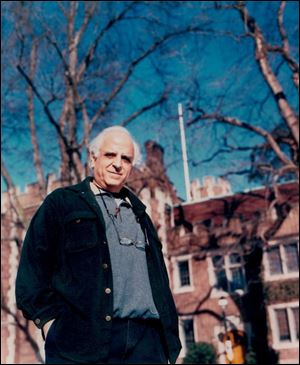
BGSU festival spotlights music, visual arts
10/13/2002
Princeton professor Paul Lansky tries to include the sounds of everyday life in his music.
Technology in the arts is the theme this week when Bowling Green State University presents “Ghosts in the Wiring,” the 23rd annual installment of its dependably adventurous New Music and Art Festival.
As always, originality and ink-still-wet newness are the guiding forces.
Over three days the university will present 16 events featuring 30 composers and 43 different compositions. Twenty-seven were written this century; two will be world premieres.
Visual art exhibits feature digital imagery and interactive virtual reality displays.
The “cyber-feminist performance art collective” subRosa will present an interactive performance titled “Biopower Unlimited! Give a Moo!”
Princeton University professor Paul Lansky is the festival's featured composer, with works performed in four different concerts. Lansky will also present a composition seminar at 1 p.m. Thursday in BGSU's Bryan Recital Hall.
Widely recognized for his interest in including the sounds of everyday life in his music, Lansky says he finds inspiration almost everywhere. His computer-generated music has been based on the sounds of speeding cars, shopping malls, and even young rappers hanging out at the entrance to New York's Lincoln Tunnel.
The British rock group Radiohead recently used his 1973 computer piece “mild und liese” in the song “Idioteque,” which is recorded on their CD release “Kid A.”
Featured on Thursday night will be Lansky's “Labyrinth,” one of relatively few works he has written for eight-channel tape. The work is also unusual for Lansky in that it uses only computer-generated sound.
“I have generally used everyday sound as a way of combining the familiar with the unfamiliar. For a long time I felt that real-world sounds were more interesting than computer-generated sounds, but today's computers are able to do all kinds of things that they couldn't do before. So, in `Labyrinth' I decided to test my old hypothesis.” he said.
Computer music is fundamentally different from live music, said Lansky.
“You to learn to negotiate space in new ways to make the room come alive.”
A composer writing for live musicians is “like a playwright who is creating a script for others to perform. Tape music is different. It's more like film; the piece is complete without intermediaries,” he said.
Curiously, as pre-packaged recorded music takes performers out of the concert experience, visual artists are using technology to put their audiences inside their increasingly malleable creations.
This new aspect can be seen in the work of digital artists Ellen Sandor and Gita
Hashemi, who will be featured along with Diane Fenster and Michael McNabb in an exhibit titled N-Space that opens at 7:30 p.m. Friday in BGSU's Dorothy Uber Bryan Gallery.
Sandor's interactive in-the-round display investigates the promise of immortality as held out by gene therapy, bio-engineering, and cloning.
Hashemi's interactive work looks at the experience of four Iranian women in the aftermath of the 1979 Iranian Revolution.
More cutting-edge computer arts technology will be on display from 1 to 4 p.m. Thursday in BGSU's Olscamp Hall. Featured will be subRosa, a political-activist group named in honor of progressive Rosas of the past, including 19th-century French sculptor Rosa Bonheur, Russian Marxist Rosa Luxemburg, Civil Rights figure Rosa Parks, and World War II's rolled-up-sleeves poster icon, Rosie the Riveter.
subRosa's performance will involve an interactive display in which the viewer's “bio-power” and “bio-political potential” can be measured, said BGSU exhibition program administrator Jacqui Nathan.
subRosa will again be featured in the 9 p.m. Friday video screening at Bowling Green's Cla-Zel Theatre.
That program will also feature two more of Lansky's computer works, “Patterns Patterns” and “ABC.” The pieces were inspired by the letters and numbers games of Sesame Street. Animation is by Grady Klein.
“ABC's basic form couldn't be more simple. My wife is doing the narration, one letter every 15 seconds. It's one of the few pieces you will ever hear in which you always know exactly were you are,” said Lansky.
Lansky is also having two acoustic pieces performed during the festival. The guitar piece “Semi-Suite” is loosely modeled on early 18th-century Baroque dance suites. The string quartet piece “Ricercare” looks back to models from the Renaissance.
An exhibition of digital works by BGSU graduate students in art will be presented at 4:30 p.m. Thursday in the Bowen-Thompson Student Union Gallery.
The New Music and Art Festival was started in 1980. Past guest composers include John Cage, Joan Tower, George Crumb, William Bolcom, and John Adams. More than 400 compositions were submitted for consideration in this year's festival.
BGSUs 23rd Annual New Music and Art Festival will run Thursday through Saturday. Concerts in BGSU's Moore Musical Arts Building are scheduled for 8 p.m. Thursday, 10:30 a.m. and 2:30 p.m. Friday, and 10 a.m. and 8 p.m. Saturday.
Ellen Sandor will speak about her work at 6:30 p.m. Friday in BGSU's 115 Olscamp Hall before her exhibit's opening at 7:30 p.m. in the Dorothy Uber Bryan Gallery. Artist Gregory Little will introduce his “Taxonomy: The Body w/o Organs” at 6:30 p.m. Saturday in the Kennedy Green Room.
Videos will be screened at 9 p.m. Friday at the Cla-Zel Theatre, Bowling Green. A 2 p.m. Saturday concert will be given in the 18th-Century Gallery of the Toledo Museum of Art.
Information: 419-372-2685 or on the Web at http://www.bgsu.edu/colleges/music/MACCM/index.html